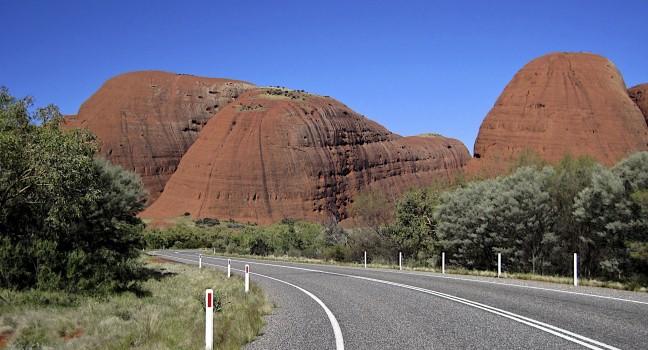Uluru and Kata Tjuta

It's easy to see why the Aborigines attach spiritual significance to Uluru (Ayers Rock). It rises magnificently above the plain and dramatically changes color throughout the day. At more than 1,100 feet, Uluru is one of the world's largest monoliths, though such a classification belies the otherworldly, spiritual energy surrounding it. The Anangu people are the traditional owners of the land around Uluru and Kata Tjuta. They believe they are direct descendants of the beings—which include a python, an emu, a blue-tongue lizard, and a poisonous snake—who formed the land and its physical features during the Tjukurpa (the "Dreamtime," or creation period).
Kata Tjuta (the Olgas), 53 km (33 miles) west of Uluru, is a series of 36 gigantic rock domes hiding a maze of fascinating gorges and crevasses. The names Ayers Rock and the Olgas are used out of familiarity alone; at the sites themselves, the Aboriginal Uluru and Kata Tjuta are the respective names of preference. The entire area is called Yulara, though the airport is still known as Ayers Rock.
Uluru and Kata Tjuta have very different compositions. Monolithic Uluru is a type of sandstone called arkose, while the rock domes at Kata Tjuta are composed of conglomerate. Both of these intriguing sights lie within Uluru–Kata Tjuta National Park, which is protected as a World Heritage site. The whole experience is a bit like seeing the Grand Canyon turned inside out, and a visit here will be remembered for a lifetime.
In terms of where to eat and stay, Ayers Rock Resort, officially known as the township of Yulara, is a complex of lodgings, restaurants, and facilities, and is base camp for exploring Uluru and Kata Tjuta. The accommodations and services here are the only ones in the vicinity of the national park. Uluru is about a 20-minute drive from the resort area (there's a sunset-viewing area on the way); driving to Kata Tjuta will take another 30 minutes. The park entrance fee of A$25 is valid for three days.
The resort "village" includes a bank, newsstand, supermarket, several souvenir shops, Aboriginal art gallery, hair salon, and child-care center.
The accommodations at the resort, which range from luxury hotels to a campground, are all run by Voyages Indigenous Tourism Australia and share many of the same facilities. Indoor dining is limited to each hotel's restaurants and the less-expensive Geckos Cafe, all of which can be charged back to your room. All reservations can be made through Voyages Indigenous Tourism Australia (www.voyages.com.au) on-site, or their central reservations service in Sydney.
Recommended Fodor's Video
Elsewhere in Uluru and Kata Tjuta
Alice Springs >
Restaurants (7), Things to do (15), Hotels (4)
West MacDonnell Ranges >
Restaurants (0), Things to do (7), Hotels (0)
Between Uluru and Alice Springs >
Restaurants (0), Things to do (0), Hotels (0)




